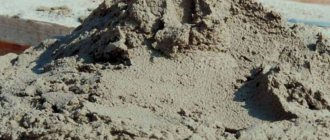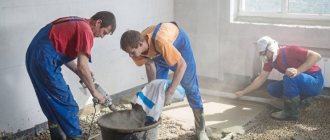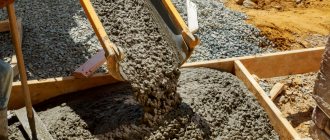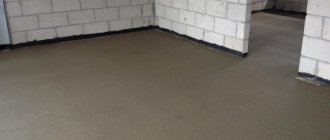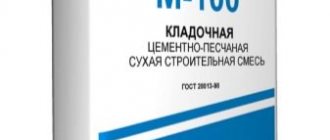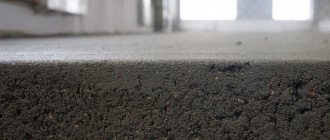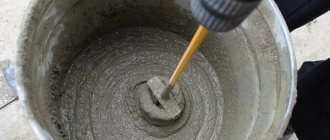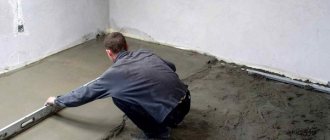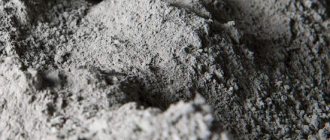In the construction industry, concrete mixtures and cement mortars are used to solve various problems. Their main component is Portland cement, which acts as a binder. The concentration of cement in concrete or cement mortar determines the strength characteristics of the foundation, masonry, as well as the quality of finishing measures. It is important to understand how to dilute cement in order to ensure the required performance properties of the finished composition. Let us dwell on the technology of performing the work, the optimal ratios of cement and other ingredients.
How to dilute cement with sand
Beginner developers who do not have practical experience in carrying out construction activities encounter problems when trying to dilute cement. The composition turns out to be too thick or, conversely, very fluid. And after hardening, it cracks and does not gain the required strength. Despite the apparent simplicity of the task, not everyone knows how to dilute M500 cement, as well as other brands of Portland cement. Let's start with the basics.
How to properly dilute cement with sand when preparing a cement-sand mortar? Builders often use the following methods for diluting Portland cement:
- The first method involves pouring water into a mixing container, followed by adding sand and cement. The ingredients of the sand-cement mixture are thoroughly mixed with the addition, if necessary, of a small amount of water;
- the second method is based on a different principle. First, the bulk components of the mixture - Portland cement and sand - are poured into the container. Then they are mixed evenly. The prepared cement-sand mixture is diluted with water to a plastic state.
Not everyone knows how to dilute cement during the preparation of cement mortar or concrete.
Regardless of the preparation technology, the ingredients are first sifted to remove foreign inclusions and large particles. Compliance with the ratios of the introduced ingredients and the quality of the fillers affect the performance properties of the finished composition. The main requirements of the preparation technology are maintaining proportions, uniform mixing and a plastic consistency of the solution, especially if additives were used. It is important to distribute them evenly throughout the entire volume of the solution.
It is important to be able to dilute cement when preparing concrete mortar. In addition to the standard set of ingredients, sand, cement and water, it includes crushed stone filler or gravel. The filler increases the strength characteristics of concrete and its rigidity. The binder is diluted manually or using a concrete mixer.
The technology for preparing the concrete mixture involves following the sequence of operations:
- Weighing ingredients according to recipe.
- Mixing sifted sand with Portland cement.
- Adding mid-fraction crushed stone to the mixture.
- Pour into water and stir the mixture until smooth.
When independently preparing concrete mortar or cement mixture for construction work, it is important to understand how to dilute the mortar.
Cement mortar includes 3 main components: water, sand, cement
Tips and tricks
When planning to prepare a cement-sand mixture, you must immediately decide in what proportion the different components will be taken, what grade of strength is needed, and what the main properties are.
It all depends on the scope of application of the mortar - so, if M50 or M75 is suitable for brickwork, then for screed prepare at least a mixture of M150, 200 and higher. The composition of any CPS includes cement, sand, water, but the result is different depending on the ratio.
Some tips from the experts:
- To prepare a plastic mixture, you can add liquid soap to the solution, previously thoroughly mixed with water.
- You need to know how to properly dilute cement and other components: first, all the dry substances are mixed, then water is added in small portions so that you can control the thickness of the mixture and achieve the ideal consistency.
- When preparing masonry mortar, take into account the brand of building material from which the walls are built. It is desirable that the parameters coincide - then the wall will have a homogeneous structure, reliable and durable.
- Before you make your own cement for plaster, you should take care of purchasing perlite. If you replace some of the sand with it, you will be able to achieve higher thermal insulation characteristics.
- For work, we use exclusively fresh cement, without lumps, produced according to technology and stored in optimal conditions - in this case, it will be possible to achieve the most uniform mixing and high adhesion.
- Detergent or soap is also added to the cement (the proportions remain the same, it is simply mixed with mixing water) to increase adhesion.
- The solution is best prepared in a container made of metal, plastic or wood.
- To thoroughly clean the sand from impurities that can reduce its strength, you can soak it in water for a short time.
- The consistency of the finished cement-sand mixture is usually checked with a trowel: the solution should be distributed evenly over the tool, but not run off (it is worth remembering that this rule works in the preparation of standard mixtures; for some tasks other properties may be important).
- The finished DSP is used for an hour after mixing, until the solution begins to thicken and harden. Therefore, you need to immediately prepare the required volume - exactly as much as you can produce in an hour.
- It is forbidden to dilute an already hardened solution with water, as it immediately loses its properties and can cause destruction of the structure/building.
- When mixing a mixture in a volume greater than 2 cubic meters, no drills or attachments will help - only a concrete mixer or ordering the required volume at the factory.
- The solution, which is planned to be used where minimal loads and low mass are noted, can be prepared with a reduced volume of sand. But this approach is only possible on the condition that before properly mixing the DSP, the master has precisely determined the specifics of the application and the remaining solution will not be used for the implementation of any other tasks.
- Mixing the cement-sand mass should last at least 20 minutes - this way the solution will be homogeneous and of high quality.
- The ratio of the proportions of the components is looked at in GOSTs and SNiPs (the opinion of experienced craftsmen is allowed), as well as in the recommendations of the manufacturer of cement, dry mix, etc.
Cement-sand mixture is a universal material that can be used to perform a whole range of works, obtaining the most durable and strong structures. Provided you select high-quality materials and follow the technology for preparing the mixture for the task at hand, everything can be accomplished quickly and easily.
Necessary tools and materials to dilute cement
Prepare the necessary tools and materials before starting work.
To independently prepare cement mortar or concrete mixture, you will need the following equipment and tools:
- concrete mixer or container of appropriate size;
- bayonet or scoop shovel, as well as buckets;
- electric drill equipped with a mixing attachment.
The choice of equipment and tools used is determined by the volume of concrete or cement mortar produced:
- with an increased batch volume, it is advisable to use an industrial concrete mixer;
- It’s easy to prepare a small amount of solution in an old bathtub, tub, or just on the site.
To get a cement solution, prepare:
- fine sand, cleared of foreign inclusions;
- Portland cement marked according to the recipe;
- additives that determine the properties of the finished composition;
- water added to the required mixture consistency.
If a concrete composition is being prepared, then the list of materials additionally includes crushed stone, gravel or other building materials that increase the strength of concrete after hardening.
Cement along with sand must be sifted through a sieve in advance, and then mixed thoroughly
Additives for preparing the batch
Basalt fibers. Photo Geostyle
In addition to the liquid soap mentioned above, other additives are used to improve the quality and characteristics of the solution:
- Plasticizers are recommended for use by beginners, they make the solution more mobile, it is easier to pour, adhesion to metal improves, fewer air bubbles are formed, and increase strength. But it is important not to overdo it with plasticizers.
- Reinforcing additives : thin fibers made of basalt, fiberglass, polypropylene, metal, providing “binding” of solution particles and restraining them during shrinkage. The solution cracks less when it dries.
- Air-entraining agents make the solution more porous, which provides increased resistance to temperature changes.
- Accelerators and retarders of mortar setting.
- Sealing.
- Anti-corrosion.
- Coloring, for obtaining solutions of various colors.
How to dilute cement mortar - brand of Portland cement and working mixture
An important factor influencing the quality of construction work is the correspondence of the markings of the binder used with the brand of the prepared mortar. Compliance with standard ratios guarantees the strength of brick walls and the reliability of the foundation. Having information about the labeling of the building materials used, and following the dilution rules, it is easy to determine how to dilute M500 cement and other brands of binders from reference tables.
In the construction industry, special standards are applied to guarantee the strength properties of the finished composition:
- when laying brick walls marked M100, cement mortar of the same grade is used;
- the stability of building walls constructed from M300 grade brick is ensured by the use of a cement mixture marked M150;
- carrying out measures for the interior and exterior decoration of building walls requires the use of a solution marked M50–M100;
- To make the concrete screed and foundation, a more durable mixture of grade M200 is used.
Remember that the marking of the finished cement mortar depends on the brand of Portland cement used in the mixture.
It is best that the brand of masonry mixture matches the brand of material used
Ingredients and equipment
To properly mix a cement solution, you need to decide on the main and additional components, as well as prepare the necessary equipment. As a rule, the choice of mixing method - manually or with a concrete mixer - is based on the required amount of solution.
So, to mix cement you will need:
- A container made of metal or durable plastic (cast iron bath, trough or stable basin) - for manual kneading. For large volumes of cement mixture, a concrete mixer is used;
- Shovel;
- Putty knife;
- Construction mixer (drill with attachments).
Since the solution is liquid for a short time, it is better to prepare suitable equipment in advance. Otherwise, you may waste time or waste materials.
The selection of ingredients must be taken seriously: their quality and mixing order play a major role in achieving the desired consistency and strength of the material. To dilute the “classic” cement mortar you will need:
- sand. Its uniformity and size determine the quality of the finished mixture. Do not use aggregate with high humidity: this will disrupt the technology, increasing the total amount of water.
- cement. The type and brand affect the strength of the mixture; they are chosen depending on the job. Here you need to know about the selection rules or follow the instructions.
- additional ingredients to improve the plasticity of the solution (plasticizers, liquid glass, etc.).
- water. It is better to make a solution using clean water, without dirt and impurities. Then the risk of violating the proportions and getting a bad result will be minimized.
